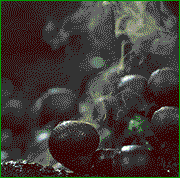|
Sylink posted:Does anyone have recommendations for a wifi thermometer + hygrometer for monitoring ? Need to monitor a small greenhouse from afar, and I'd like historical data so I can see what highs/lows were via my phone or whatever. I like Goveeís, but Iíve only used their Bluetooth models.  Iíve had all three of these models. Middle one died mysteriously in my greenhouse, so I wouldnít recommend it. Top one has been doing fine in the same service for over a year. Takes AAA batteries. I had two of the mini ones on the bottom (they use lithium primary cells), but I killed one with submersion in water (my bad) and the other in a broken freezer with a bunch of dry ice. Iím pretty sure if I read the manual that that would be well outside its operating specifications, so whatever. It monitored that freezer like a champ for the couple of days it took to get a new one delivered, but if I had to go it again I would put it in a bag with some desiccant before freezing it and perhaps it would have survived. Point is, the models with the larger screens can probably take the temperature and humidity swings of a greenhouse. The ones without screens might be hardier, but theyíre the same price so Iíve never bothered.
|
|
|
|

|
| # ? May 28, 2024 23:44 |
|
just another posted:If you're envious now, just wait'll you see how badly I gently caress everything up next season. I'm sure you'll do great. With that much space it's got to be near impossible to gently caress up. Garden news: We harvested 4 lbs of tomatoes at lunch today. Looks like trying to make four pints of salsa this weekend for the first time. I am hopeful it turns out well. Looks like raccoons or something ate every single one of my grapes. At least now I have sour grapes when I look at my grape trellis. This weekend I should be able to have time to actually get out and weed the flower garden. I'm starting to think on Fall projects. There's a section of my yard that's on a hill I'd like to replace the grass there with mulch/raised beds. Being on a hill I would be worried about erosion happening and everything not in the raised beds getting washed down the hill. Anyone have any insights or videos I should watch about that kind of garden area? I got to thinking about this because one of my walks I saw a house that they put down a thick tarp with rocks on top to stop it from blowing away. I assume it was to kill off the grass in that area.
|
|
|
|
 Pumpkin season lives
|
|
|
|
I realized the other day that my sugar pumpkins will be ready within the next week or so, but the big Cinderella ones are still green and getting bigger. Thank goodness. I can puree the baking ones and just freeze it all until it's spooky pie time.
|
|
|
|
Was gone for two weeks and the tomato's definitely enjoyed my absence But then: shock. Blight.  I trimmed back a bunch, all infected parts hopefully, plus write a bit more so they can ventilate again   We'll see what comes of this I guess
|
|
|
|
I'm always the first to bang the drum about organic gardening BUT.... We got hit with blight pretty hard this year as well. In the past I've usually just culled plants and said gently caress it for the season. I only have six tomato plants this year so we went nuclear, relatively speaking, and applied Immunox (Myclobutanil) with a hose sprayer over a few days straight and it just turned everything inside out. I'm used to using copper fungicides but this was a whole different level of effective. Will I grow a fourth nipple? Probably. Are my tomato plants bouncing back? Absolutely. Four out of five flipper babies, would recommend.
|
|
|
|
mischief posted:I'm always the first to bang the drum about organic gardening BUT.... So long as you use PPE properly, otherwise it wonít give you flipper babies, just no babies. I prefer to go natural remedies too, but sometimes you just need a chemical solution or youíre going to need a time machine. I have some Japanese spindle shrubs that Iíve been fighting with mildew all year and Iíve been debating. Itís not been wet enough for a month and theyíre all covered and itís spreading anyway. Copper just isnít working for it.
|
|
|
|
Don't think my pumpkins are going to make it. I've been savage about spraying fungicide and trimming leaves with powdery mildew, which has denuded most of my vines now at this point. The leaves I have left look diseased and are host to swarms of small black bugs. Hoping my one little pumpkin manages to make it to ripeness, but not optimistic. On the plus side, my far too numerous tomatoes continue to produce more quickly than I can keep up with. Definitely going to pare things down next year. The sun golds and san marzanos will stay. The purple tomatoes, while pretty, are all water and have been a nightmare to try and process into anything. The gladiators are good for saucing and the medium rares are a tastier slicing tomato. Though I'm finding I can only eat so many BLTs or tomato omelettes.  Thinking maybe more pepper varieties next year to make up some of the space. Gardening is always a devil's bargain for me... which food that I like will I ruin by having too many of them over summer? (Looking at you, zucchini...)
|
|
|
|
Paradoxish posted:Vine borers aren't too bad if you take a defensive approach. Grow your zucchinis vertically if you can and trim off all the lower leaves, then check the stem for eggs. Keep the whole bottom part of the stem doused in diatomaceous earth and reapply it after it rains. I've been paying closer attention and the plants are in raised beds. I think I'm going to make it at this point.
|
|
|
|
Schmeichy posted:
I had several like this in June, before the vine borers arrived and ruined everything.
|
|
|
|
When is the earliest I can get away with planting a golden delicious apple tree for Fall planting? Iíve got two that are scheduled to arrive on the 15th of this month (I didnít make this schedule) and Iím wondering if I need to call the nursery and push that back.
|
|
|
|
I. M. Gei posted:When is the earliest I can get away with planting a golden delicious apple tree for Fall planting? Iíve got two that are scheduled to arrive on the 15th of this month (I didnít make this schedule) and Iím wondering if I need to call the nursery and push that back. The least risky way is to wait until the trees in your area are dormant but if they're in pots you can theoretically transplant out at any time of the year. Having said that, I'd be cautious about putting anything out to bake and get hit by water stress like we have now at this time of year. otoh if you're in an area in North America that's getting flooded out,  You could just take delivery of them now, put them somewhere where the pots are protected from direct sunlight and overheating the roots, and keep them watered until they go dormant. Dig a hole where they're going to go, put the pot in level to the surrounding soil, backfill with light mulch, then dig up and transplant properly after dormancy. For me it would also depend on the cost of the tree. If it's a $15 mail order twig I'm far more willing to gently caress around and find out than with an $80 custom rootstock special. That one stays in the pot until winter / early spring.
|
|
|
|
I. M. Gei posted:When is the earliest I can get away with planting a golden delicious apple tree for Fall planting? Iíve got two that are scheduled to arrive on the 15th of this month (I didnít make this schedule) and Iím wondering if I need to call the nursery and push that back. Are they bareroot or in containers? Containers are probably fine-Iíd just keep them in the containers on the porch or something till they go dormant and plant in December. Maybe pot them up a size if they seem rootbound. Anyone shipping bareroot trees to the SE in the middle of August had better be prepared to replace them for free. I doubt theyíd survive the back of the truck, much less hot, dry September in the ground. Thanksgiving to Valentineís Day is the best time to plant trees down here. Youíll get a happier, healthier tree if you wait to plant at the right time instead of trying to plant one now. Itís not going to grow anymore this year anyway, and adding a bunch of stress will set it back further.
|
|
|
|
I can't decide what's going on with one of my pear trees. Looks like fire blight, can't find any cankers or weeping, and the limbs seem to be surviving. It keeps happening during the heat waves we've been having here in the PNW. Since the first one I've been watering as best I can within the drought restrictions. Could be just too darn hot for the variety?   I'm skeptical about its chances of survival till fall, especially if the heat continues. Luckily it's more of a stewing variety that I don't care for.
|
|
|
|
Bi-la kaifa posted:I can't decide what's going on with one of my pear trees. Looks like fire blight, can't find any cankers or weeping, and the limbs seem to be surviving. It keeps happening during the heat waves we've been having here in the PNW. Since the first one I've been watering as best I can within the drought restrictions. Could be just too darn hot for the variety? Just to run the checklist, are you deep watering*? When you dig up the soil around the tree after watering, how deep does the water penetrate? Are you fertilizing as well? Do you have a thick layer of mulch from an inch away from the trunk to a few feet out? It's entirely possible that it's too hot, what's the variety and what part of the PNW are you in/what temperatures are seeing locally? I'm in the PNW as well so are we talking coastal/island, Seattle/Tacoma/Everett, Eastern Washington somewhere, general answers are totally fine. Also, never forget places like the WSU extension sites. You may find http://treefruit.wsu.edu/ to be particularly useful. *Techniques like leaving a hose that's turned to a heavy trickle (size of your finger/thumb) next to the base of the tree for an hour or two, or poking a small hole in a 5 gallon bucket, filling that up and leaving it at the base of the tree, a soaker hose around the base of a tree (not touching the trunk, just a few inches away to the drip line, very loosely for a few hours. Saved some japanese maples this way during the heat dome), etc. Solkanar512 fucked around with this message at 22:08 on Aug 2, 2021 |
|
|
|
I'm on Vancouver Island, zone 8b. No rain here for almost 50 consecutive days now. My best guess is an Anjou tree. The people who planted it just referred it as the stewing pear tree, and they're green and stay super firm. I do the dribble trick, about eight hours at a time on a very low trickle. The internet says it's a drought tolerant variety so maybe it is some form of canker... I've got to spray next year for rust anyways so I might throw in a copper sulfate application to be safe.
|
|
|
|
Bi-la kaifa posted:I'm on Vancouver Island, zone 8b. No rain here for almost 50 consecutive days now. My best guess is an Anjou tree. The people who planted it just referred it as the stewing pear tree, and they're green and stay super firm. I do the dribble trick, about eight hours at a time on a very low trickle. The internet says it's a drought tolerant variety so maybe it is some form of canker... I've got to spray next year for rust anyways so I might throw in a copper sulfate application to be safe. Do you have cicadas in your area? They can cause similar looking damage. The mama cicada crawls out the end of branches and drills a little hole to lay eggs in and it kills the last 6Ē or so of the branch.
|
|
|
|
Bi-la kaifa posted:I'm on Vancouver Island, zone 8b. No rain here for almost 50 consecutive days now. My best guess is an Anjou tree. The people who planted it just referred it as the stewing pear tree, and they're green and stay super firm. I do the dribble trick, about eight hours at a time on a very low trickle. The internet says it's a drought tolerant variety so maybe it is some form of canker... I've got to spray next year for rust anyways so I might throw in a copper sulfate application to be safe. I would double check after watering to see how deep the water actually penetrates and mulch around the tree to ensure it isn't evaporating out too quickly. Other than that, I think you're set. Now that I see Kaiser's response, insects can be a larger problem for drought stressed trees, so that's a good thing to check for. I had no idea that we even had cicadas in the first place, crazy!
|
|
|
|
Not many pests around this year, including cicadas. It's been a banner year for mellons and peppers I tell you what. I'll check the penetration... I've been looking for an excuse to get a moisture meter. I've been so scared of using a noticeable amount that the stream could be just evaporating before it gets anywhere. I agree with Kaiser on the fruit aspect, and I'm a little bewildered that besides some cosmetic defects the fruit has remained in remarkable shape for the type of year we've had. If it is fire blight I'm hesitant to prune now if I can save the fruit. According to the internet it shouldn't spread now anyways since it's dry as hell here.
|
|
|
|
I have a question about germination. Let's say you were only allowed to plant your garden by throwing seeds at it from an airplane. What could you do to maximize your seeds' chances of survival? I'm thinking about trees by the way. This guy talks about using clay and compost.. https://foresttech.events/seed-dropping-drone-being-trialed/ posted:The seeds are mixed with water, clay and compost and compressed into a small ball shape. Each one weighs about two grams, is about the size of a lolly, and contains five to six different native seeds gathered from the area. Ten drone flights could spread 50,000 of the tiny parcels in just half an hour, Vye said. In this video: https://www.youtube.com/watch?v=U7nJBFjKqAY&t=241s they mention fertilizer and ghost pepper. Both mentioned that they plant a mixture of different species that compliment one another. If you wanted to spread sugar maples (Ace saccharum) over a coniferous scrub forest what do you reckon might be a good mixture to increase your odds of germination? It's probably a good idea to start by rolling the seeds into a ball of something and seeing how they do without being thrown out of a plane, but I don't have a great idea of where to start. Is charcoal a good idea? I hear it's good for not drying out. Peat moss is suggested for use as a medium for cold-stratifying maple seeds, but I don't think it rolls into a ball very well. But really I don't know enough about silviculture to form a valid opinion. How much of what kind of fertilizer can you give to baby trees without burning them? If they're like cannabis you have to go easy on the nutrients when first starting out or else you'll burn their leaves. Is that universal? A guy at the nursery told me that bone meal is super important for transplanting trees. But is it important for trees or important for transplants? Sorry for all the questions. I don't know anything.
|
|
|
|
Can you explain your plan a little bit more? It sounds suspiciously like you're trying to gently caress with a whole forest for fun and the fact that you don't know the answers to these questions suggests you probably aren't qualified or authorized to do that sort of thing.
|
|
|
|
I've got several acres of red cedar that I'd like to plant sugar maple on. e: 20 years ago it was pasture. The red cedar are only there because cows don't eat it. Legally the land could be growing soybeans, canola, corn, whatever. I'd rather it were deciduous trees. They are more efficient at converting atmospheric C02 to forest floor detritus. Due to climate change I am of the opinion to accelerate succession by planting climax species. According to some maps I found (https://sis.agr.gc.ca/cansis/publications/maps/cli/250k/for/index.html) hard maple is what would be growing here naturally if it hadn't been for white people cutting all the trees down. DreadLlama fucked around with this message at 02:20 on Aug 3, 2021 |
|
|
|
You might need a forestry engineer's opinion, or someone who's familiar with the variables involved with switching from one dominant tree species to another. Step one is probably cut it all down though so I'd start with that. E: or burn it down E2:  It's fire blight Bi-la kaifa fucked around with this message at 02:31 on Aug 3, 2021 |
|
|
|
DreadLlama posted:I've got several acres of red cedar that I'd like to plant sugar maple on. Buy bareroot in bulk and plant in a cleared area, thatís going to be massively more successful than scattering seeds.
|
|
|
|
That's what I've been doing. I guess I could keep at it. How long can bareroot saplings last if you keep them in a cooler? The guys I buy from only offer bulk discounts once a year and I suck at planting trees so I can't do more than 20 in a weekend. And because they make planting a once-a-year thing, I can't do more than 20 a year. It sucks and it's slow. This is why I'm interested in aerial seed spreading. The thing about sugar maples is they're adapted to starting out life in partial shade. They wait for a hole to open in a forest canopy and then shoot up to take advantage. I'm having trouble with the open field planting. They seem to require watering. Ones I've planted under coniferous cover seem to survive without being watered. How much massively more successful are we talking? I do my best with bareroot planting but I've only got maybe a 50% success rate after 4 years. This year I've got 20 trees in the ground with a soaker hose running along next to them and they're all in tomato cages with chicken wire wrapped around to keep the deer away. Maybe more than half will survive this year, but I'm going to have trouble scaling up. Maybe I can plant 20 more trees next year, and then 20 more the year after that. With my very best efforts I might plant 100 trees in 5 years. I feel like I need an alternative. Even if most of the seeds die, I can still throw out a few hundred a day if I put them in a seed spreading drone. Or do you suggest planting bareroot trees in a field and then not doing anything more for them? Someone in the sugar maple thread called that "deer candy". If you're going for an R-type selection reproductive strategy aren't seeds the way to go?
|
|
|
|
DreadLlama posted:That's what I've been doing. I guess I could keep at it. How long can bareroot saplings last if you keep them in a cooler? The guys I buy from only offer bulk discounts once a year and I suck at planting trees so I can't do more than 20 in a weekend. And because they make planting a once-a-year thing, I can't do more than 20 a year. It sucks and it's slow. This is why I'm interested in aerial seed spreading. Iíve pulled out more maples in a year than most people would plant trees. Maples, even sugar maples, like to put down seed over a fairly wide area and carry all the nutrients theyíd need to get started. Considering that they like to whirl, Iíd just start spreading them farther afield than where theyíd spin naturally. Iím not sure if Iíd even bother planting them. They seem to do just fine just landing on the ground and getting started. The hardest part would be finding a tree dropping seed and collecting it. But itís potentially next to free if you can rake it up yourself. If I could borrow an ATV or dirt bike Iíd probably just take a bunch and sprinkle them all over the place. If you already have a drone that could carry a bunch I might just load it up and see if I could get them to hit the ground, but youíre probably better off doing it closer to ground level so they donít get all stuck in the cedars. Youíre going to spread hundreds to thousands this way, but if you can collect from a few different trees then you should be off to a good start. Maples throw so very many seeds, take advantage of how nature wants to reproduce. Iíd consider doing most of the acreage with seed spreading, and then making yourself a nice little grove thatís close to where you can easily get water and then get a head start there with planting and maintaining. Fwiw, Iíve pulled full maple tap roots out from under a porch after a few months of growth and theyíre just big. So maybe take handfuls of seed and toss them under the cedars too. Then they can hide under the cedar until you want to let them take over. Then you just cut back the cedar so they can.
|
|
|
|
DreadLlama posted:I have a question about germination. Let's say you were only allowed to plant your garden by throwing seeds at it from an airplane. What could you do to maximize your seeds' chances of survival? I'm thinking about trees by the way. The short answer is that if you are trying to reforest something by throwing seeds at it from an airplane (this actually does get done, though usually with a helicopter) you don't need to do anything but throw seeds at the ground. You do need to throw the right kind of seeds at the ground, ideally at the right time. Trees have different strategies for reproduction-some are dispersed by wind (most conifers, maples, poplar, ashes, cottonwoods-anything with a light seed that floats or flutters), some rely on squirrels or jays or other hoarding animals burying them and forgetting about them (oaks, hickories, beeches, walnuts), some rely on birds or deer or something else eating their seeds and pooping them out somewhere far away (fruit trees especially, black cherry, mulberry, wild plums, persimmon, magnolias). Some don't even really rely on seeds that much and just spread vegetatively through root sprouts or trees getting swept away and relocated in a flood. What this means in practice, is that if you want to scatter some seeds from the air, you should probably use seeds from trees that naturally rely on wind dispersion. They are adapted to germinate by just resting on the ground, maybe covered in some leaf litter. They don't need a squirrel to bury them in the dirt, or a deer to deposit them in a nice little pile of fertilizer. However, within that big category of 'wind-dispersed seeds' we need to think about another big huge factor in forestry-site. Where are these trees going to be planted? A nice, flat old field with good dirt? The dry top of a windy mountain? A poorly drained bottom? An existing forest? Different trees have different light and exposure requirements-some trees are 'pioneer' species that need a lot of light, are relatively short-lived, and don't like much competition but are usually tough and tolerate poor soil and droughty conditions. They're usually the first trees to colonize an old field or cut-over land, and lots of them are bird or wind-dispersed! Common ones in eastern North America are green ash, black cherry, persimmon, locust, sweetgum, red maple, and pines of all sorts. Other trees are 'climax' species. They are usually more shade tolerant, slower growing, long-lived, and less tough and drought tolerant. They hang around in the understory, biding their time until the big pine they've been growing under for 40 years gets blown over in a storm or struck by lightening or gets pine beetles or whatever and they shoot up to take its place in the canopy. They tend to have heavier, animal dispersed seeds, and many also spread through root sprouts. Common examples are oaks, hickories, beeches, and sugar maple. Barring a huge change in the forest (fire, large wind storm, clearcutting) a climax forest will tend to perpetuate itself indefinitely-once the canopy is an oak/hickory/sugar maple mix, their babies hang around in the understory until trees die-pioneer species can't tolerate the shade and never get a chance to get going unless there is a large clearing. So sounds great, grab handful of red maple and green ash keys, scatter them over your scrub conifers and you'll have hardwoods soon, right? Well, maybe. When I go in the woods with my great uncle who's been a forester for 65yrs, the thing he always thinks about every stand or area of trees is 'why is this here?' What is this little patch of forest's history? Was it cut over in the 1860s, cut over in the 1930's, and hasn't been cut since? Around here that means it's a mixed pine/oak/hickory forest where the climax hardwoods haven't quite overtaken the pioneer pines, and if you clearcut it tomorrow, you'll get another pine forest. It might be a stand of scrubby conifers like you have-why is that there? Is it because the land was clearcut 10 years ago, or is it because it's poor, sandy, droughty, acidic soil that only pines will grow on, or is it because the soil is okay but there are way too many trees and they've stagnated-no tree can quite outcompete it's neighbor and so instead of 200 nice trees per acre there are 2000 lovely trees? Those pines might be 20' tall, but they might be be 50yrs old or they might be 10 yrs old. Site and soil conditions are going to make a big difference in your ability to magically plant a maple forest. All that being said, scattering seeds from helicopters isn't done very much in forestry anymore. There's too many variables, and usually it winds up with too many trees. In modern softwood forestry, plantations of seedlings are preferred because we've been breeding pine trees for the past 50 years, and now are on the 2nd or 3rd generation of hybrids and selective breeding. Instead of relying on the children of whatever trees nature grew there, now we can plant trees with good genes that we know will grow fast and straight, and probably have been selected for disease/bug resistance. We can also plant the right number of them, so they quickly shade out the grass and other tree species we don't want, but don't compete too much with each other. Even plantations aren't usually fertilized, though sometimes they are. 20-30 yrs ago when paper companies were growing southern pine on very short (10-15yr) rotations for pulp, it made sense to fertilize them, but now on a 30-50yr rotation for southern pine the cost isn't worth the little bit of benefit, especially with timber prices being terrible. If you want a hardwood forest quick, planting bareroot seedlings is the best option, but it's expensive and nto always practical. It works okay in old fields where there aren't many trees, but deer and other animals can be a huge problem. If the existing growth is too thick (like your situation) a person or machine can't get in there to plant seedlings. There's also cost-even wholesale, hardwood seedlings are $.30-.50 each vs. $.05-10 for pine seedlings, and pines, being tough pioneer species, tend to have much better survival. Add labor on top of that and ~300-1000 seedlings per acre and planting forest gets quit expensive. Anyway, tl;dr: if you plant the right kind of seeds at the right time and in the right place, they shouldn't need any help. Scatter them in the fall and they'll get all the cold stratification they need over winter. That was all very general and longwinded-if you have more specific questions about how to propagate and grow XYZ tree species in ABC location I can maybe point you in the right direction.
|
|
|
|
DreadLlama posted:That's what I've been doing. I guess I could keep at it. How long can bareroot saplings last if you keep them in a cooler? The guys I buy from only offer bulk discounts once a year and I suck at planting trees so I can't do more than 20 in a weekend. And because they make planting a once-a-year thing, I can't do more than 20 a year. It sucks and it's slow. This is why I'm interested in aerial seed spreading. I missed all these replies while writing my too-long post. It sounds like you already know everything in it. If you want to start a hardwood forest from scratch with no existing neighbouring hardwoods to seed in naturally, you need to mow everything down, and basically do a hardwood plantation. Hire some people to plant X00 trees per acre. Ask your local forester what that X should be for the species you want to plant. My forester friends strongly recommend tree tubes if youíre in an area with lots of deer. With the tree tubes and seedlings and site prep, youíre probably looking at several hundred to $2000/acre for planting costs, at least around here. Bareroot seedlings do not keep well. If itís very cold and wet, maybe a week or two max, but just a few hours of being warm and dry can kill them. Down here we can plant all winter long, but in an area with frozen ground I imagine the time when the nursery can lift seedlings and you can plant them is frustratingly short. I would ask yourself if you really need a sugar maple climax forest. Just because thatís what was there in 1760 doesnít mean thatís what was always there. Between storms and fires and floods, at some point since the last ice age, your little field of cedars probably has been a grassland of cedars before, and then it turned into a forest of cedars and pines and ashes, and then slowly turned into a birch/beech/maple forest. If you leave it alone for 100 or 200 years, there will probably be a sugar maple climax forest there again. Unless you want to spend serious money site prepping it and planting it, letting nature take its course may be the best option. If you want to try seeding it, Iíd do some minimal site prep. If the cedars are big enough to make seed, cut them down. If you have access to tractor/equipment, mow the field and disk it. Scatter a bunch of seeds of pioneer species, in early fall/late summer (look at the trees and see when theyíre dropping seed). Iím not familiar enough with your climate to be able to make recommendations, but I know the US forest service has some recommendations for trees for old mine sites and I imagine there is an equivalent Canadian publication for reclaiming old fields/industrial sites. With the emerald ash borer, Iíd stay away from green ash which is sort of a perfect tree for that use, but there are lots of other options. Sugar maple probably isnít one of them. Look at whatís growing along the edges of the highway. Plant those. (Itís probably cedar-they are a great pioneer species and they love old fields).
|
|
|
|
Thank you for the detailed reply. I suppose letting nature take its course is certainly the easiest option. You are correct about the frustratingly short planting season. One year I thought I was He-man and ordered 80 trees. I planted them all but by the end I may as well have been planting toothpicks. Most never sprouted leaves. I am fortunate in that there's sugar maple population in old field boundaries. I assume that they're seeding but I don't seem to have many sugar maples popping up in the middle of old fields. I assumed maple seeds just didn't blow that far. Are you saying if I cut down the cedar the maple trees would have a better chance of reproducing? I hadn't really thought of cutting trees down as a being constructive.  I can personally verify that the two red trees in the top center are sugar maples. Are they putting seeds in the field to their right probably? If so, would going out with the chainsaw actually be a useful thing for encouraging their offspring to grow there?
|
|
|
|
Itís too many beans for one man and none of my friends are biting on the prospect of free beans  
|
|
|
|
Solkanar512 posted:I had no idea that we even had cicadas in the first place, crazy! I don't think we do on the island. We have some ugly bugs, but not that ugly. otoh I recently discovered we have (had?) a colony of fireflies behind Courtenay. Who knows? Life finds a way. Bi-la kaifa posted:I'm on Vancouver Island, zone 8b. No rain here for almost 50 consecutive days now. My best guess is an Anjou tree. The people who planted it just referred it as the stewing pear tree, and they're green and stay super firm. I do the dribble trick, about eight hours at a time on a very low trickle. Things are so dry on my part of the island I've been having trouble getting water to soak in - it just runs off away from the tree even after an extended period of time with little to nothing penetrating the crust. Someone in the climate change thread suggested putting a drop or two of a surfactant like dish soap in 4 litres of water. Makes an amazing different. Hit the area around the base of the tree with a watering can then follow with a hose trickle afterwards - much more effective. Bit nuts that we have to be using desert gardening techniques here. Bi-la kaifa posted:E2: Ah crap. Haven't had a pear tree survive that yet. The arbutus manage to soldier on after an attack. Not sure if that will be true after this summer's drought.
|
|
|
|
Sockser posted:Itís too many beans for one man and none of my friends are biting on the prospect of free beans You could always dry them and make Shucky Beans
|
|
|
|
Hexigrammus posted:Ah crap. Haven't had a pear tree survive that yet. The arbutus manage to soldier on after an attack. Not sure if that will be true after this summer's drought. I asked some hort friends and apparently I have nothing to lose if I try to save it by pruning it way back, but it's likely a gonner. Too bad.
|
|
|
|
We have a light-hearted succulent thread going in DnD. Feel free to cross post  https://forums.somethingawful.com/showthread.php?threadid=3975333
|
|
|
|
I completely forgot to mention Iím in zone 8b, although I think Iíve posted elsewhere enough that a lot of people know that already.Kaiser Schnitzel posted:There is no fall planting in the SE. Get them delivered and planted in December. Theyíre bare-root. Kaiser Schnitzel posted:Anyone shipping bareroot trees to the SE in the middle of August had better be prepared to replace them for free. I doubt theyíd survive the back of the truck, much less hot, dry September in the ground. Itís Stark Bros, so yeah theyíll replace for free. In fact they have a 125% money back guarantee now, so they actually pay me if my tree dies. HOWEVER theyíve hosed up my golden delicious orders twice already, so Iím probably not gonna have them push this delivery back (because they may run out of stock before getting to me (again) if I do). Instead Iíll put them in pots until planting time. I just need to know what kind of soil to put them in in the pots; should it be just potting soil or a mix of potting and native soils?
|
|
|
|
Lol good luck. I canít imagine how a bareroot, leafed out tree is going to ship in august. I doubt it will matter what you plant it in-potting soil or native dirt of a mix is fine. Make sure it drains well and gets plenty of water. Donít murder an innocent tree and tell them not to ship till December. DreadLlama posted:Thank you for the detailed reply.
|
|
|
|
Well chainsaw + bareroot saplings are certainly more economical than drone-based seed spreading. I'll wait a couple years and thin out the scraggliest ones and replace them with maples. I like the idea of letting the canopy close over. Open fields are uncomfortably hot.
|
|
|
|
DreadLlama posted:Well chainsaw + bareroot saplings are certainly more economical than drone-based seed spreading. I'll wait a couple years and thin out the scraggliest ones and replace them with maples. I like the idea of letting the canopy close over. Open fields are uncomfortably hot. Do you have part of a watershed (creek, stream etc) on your land? If you are trying to restore forest, you should talk to a watershed council or other forest restoration special interest group. A)they actually know what they are doing as it's very different then gardening, B) they may be able to provide plants and man power. Planting all one tree species is not how forest restoration works. Also, typically starting with trees is not the easiest way to speed up succession, unless you use tree species that can handle full sun and edge effects. Typically shrubs are a better starting point.
|
|
|
|
Pinus Porcus posted:Do you have part of a watershed (creek, stream etc) on your land? If you are trying to restore forest, you should talk to a watershed council or other forest restoration special interest group. A)they actually know what they are doing as it's very different then gardening, B) they may be able to provide plants and man power. Watershed or not, this is deep in to "call your local county ag extension office". Also, yes....nature abhors both a vacuum and monoculture.
|
|
|
|

|
| # ? May 28, 2024 23:44 |
|
Well my original plan was to not cut anything down and throw maple seeds all over the place. I had figured that adding maple seeds to existing shrubland would result in maple trees. Unfortunately I have contacted the locals who plant trees for free as part of the managed forest tax incentive program, and they were willing to plant white pine in open fields. They were not willing to help me develop a sugarbush.
|
|
|

































